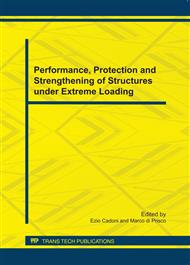p.503
p.509
p.515
p.521
p.527
p.533
p.539
p.545
p.551
An Experimental Study on the Fire Behavior of Concrete Segments in Tunnel Linings
Abstract:
As soon as the plan to build deep and long tunnels in Korea was announced, guaranteeing fire-resistance of R/C tunnel linings became an important issue. As a matter of fact, the R/C segments used in bored tunnels are structural members which are requested to resist both the transverse pressure of the soil and the longitudinal thrust of the TBM. Because of the temperature sensitivity of the high-performance concrete (compressive strength>40 MPa) that will be used, proper measures should be taken against possible fire-induced damage, like surface spalling and deterioration of the reinforcement. In the past, concrete linings were built in Korea with scanty attention to their fire safety, as demonstrated by the lack of studies on fire resistance of both materials and structures. Therefore, in this study the objective is how to improve the safety of R/C tunnel linings in case of fire, by comparing the damage observed in some full-scale tests recently performance in Korea with the damage observed in the tests performed by EFNARC (European Federation of Producer and Applicators of Specialist Products for Structures) and by investigating the fire behavior of a concrete lining as a whole.
Info:
Periodical:
Pages:
527-532
Citation:
Online since:
July 2011
Authors:
Keywords:
Price:
Сopyright:
© 2011 Trans Tech Publications Ltd. All Rights Reserved
Share:
Citation:


